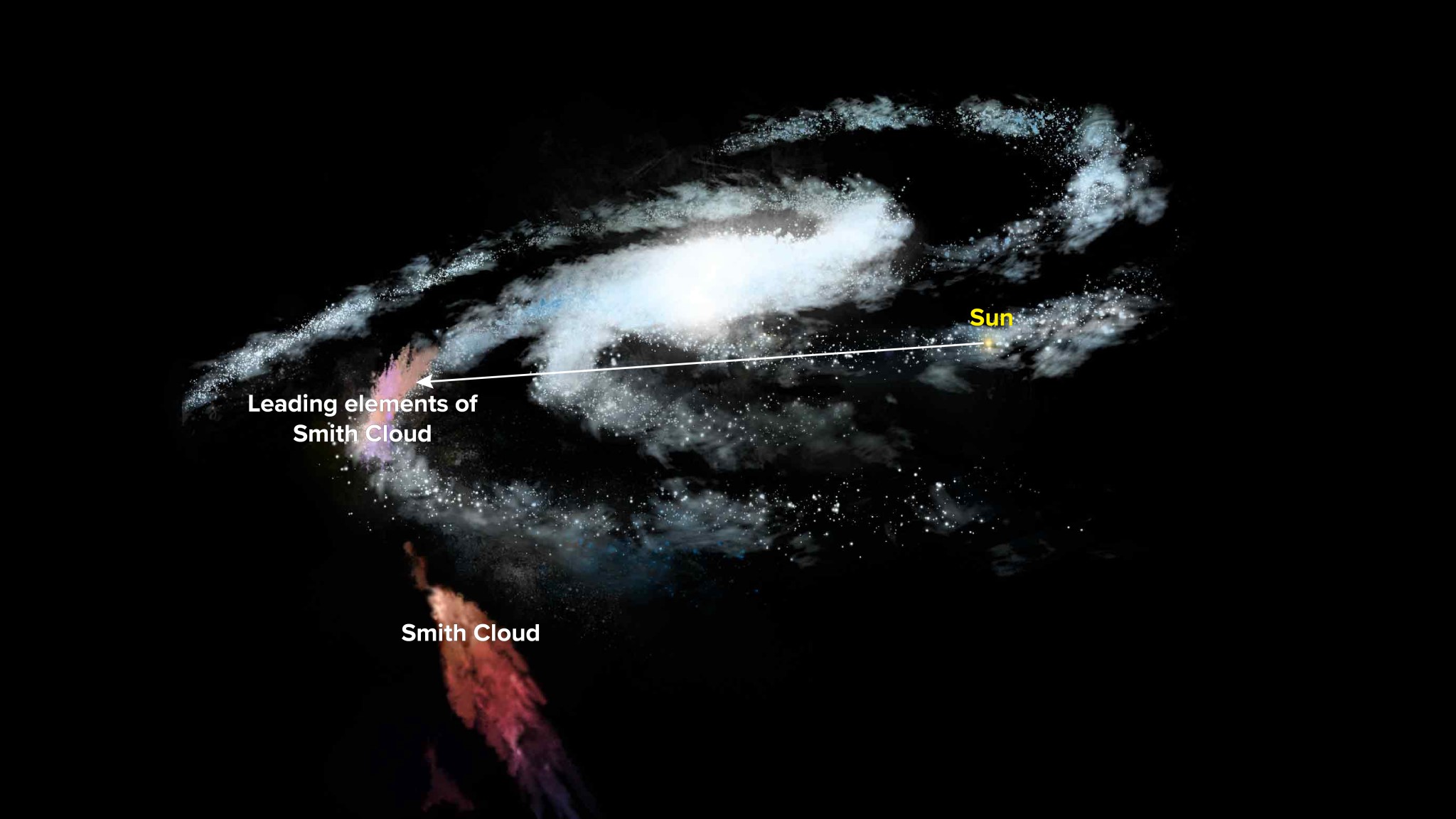New radio images from the the U.S. National Science Foundation Very Large Array trace a pair of powerful plasma jets launched by galaxy VV 340a’s central supermassive black hole, which appear to be driving hot coronal gas out of the galaxy and shutting down future star formation.
Recent News
Radio Telescopes Uncover ‘Invisible’ Gas Around Record-Shattering Cosmic Explosion
Astronomers using the U.S. National Science Foundation Very Large Array and the Atacama Large Millimeter/submillimeter Array have revealed a dense cocoon of gas around one of the most extreme cosmic explosions ever seen, showing that a ravenous black hole ripped apart a massive star and then lit up its surroundings with powerful X-rays.
New Discovery Challenges Evolution of Galaxy Clusters
Peering back in time, around 12 billion years, astronomers using the Atacama Large Millimeter/submillimeter Array (ALMA) have found the most distant and direct evidence of scorching gas in a forming galaxy cluster, SPT2349-56. The hot plasma, seen when the Universe was just 1.4 billion years old, is far hotter and more pressurized than current theories predicted for such an early system.
Astronomers Spot Differences in Thickness of Milky Way Galaxy

Astronomers using the National Science Foundation’s Green Bank Telescope targeted the Smith Cloud for their observations, however, the Milky Way’s inner galaxy obscured their view. While these scientists didn’t find what they were originally looking for, they did observe something new about this part of our home galaxy. This inner part of the Milky Way appears to be half the size of the outer part! Image credit U.S. NSF/ NSF GBO/ P.Vosteen.
Scientist from U.S. National Science Foundation’s Green Bank Observatory reveal parts of inner galaxy may be thinner than outer galaxy
Space may appear vast and empty, but it’s full of cosmological objects that are invisible to the human eye. From our vantage point on Earth, many of these objects fall between astronomers and what they hope to observe, impacting what they find. This scenario was recently encountered by scientists at the U.S. National Science Foundation’s Green Bank Observatory (GBO), who were attempting to study the Smith Cloud, tucked away behind dense layers of gas and dust in our own Milky Way Galaxy.
The Smith Cloud, containing enough gas to fill one million Suns, is expected to crash into the Milky Way—in about 27 million years. Astronomers have been intrigued by this monstrous high velocity cloud since its discovery in the 1960s. GBO’s Green Bank Telescope (GBT) and 20-meter telescope, along with NASA’s Hubble Telescope, are the primary tools that have been used to study this massive and mysterious body of gas.
GBO scientist Toney Minter planned to observe the spot where part of the Smith Cloud is now interacting with the Milky Way. At this distance, and on the other side of the Milky Way, this observation is tricky, even for a telescope as sensitive as the GBT. Minter was looking for dust and the faint emissions of hydroxl molecules (OH). The Smith Cloud should have very little to no dust and OH, while most clouds in the Milky Way contain both. If Minter found an area of accretion in the Milky Way where parts of the Smith Cloud had begun to mix, he would see the differences in their composition, and learn more about this interaction.
“I knew there was a low probability that I’d find what I was looking for—and I didn’t,” laughs Minter, “But this is all part of the scientific process. You learn from what you DO and DON’T find.”
Instead, Minter’s observation revealed information about the structure of the inner part of our home galaxy. While looking through the Milky Way to search for OH molecules in his target area, Minter determined the thickness of the layer of molecules in the inner galaxy. This revealed the scale height of molecular gas in the inner Milky Way, measuring in around 100 parsecs, or 330 light-years across. Observations of molecules in the outer parts of the Milky Way are about 200 parsecs, or double the thickness.
What does this mean for what scientists know about the Milky Way? Minter adds, “All I can currently say is that the data we see from this part of the inner galaxy shows that it’s different from the outer galaxy. We need more observations to learn more about what this means. That’s why astronomy is exciting, our knowledge is always evolving.”
Minter’s initial findings will be shared at a press conference, Tuesday, June 11 at 10:15am CST at the 244rd meeting of the American Astronomical Society June 9-13th in Madison, Wisconsin.
This news article was originally published on the GBO website on June 11, 2024.
Recent News
The NSF Very Large Array Helps Reveal Record-Breaking Stream of Super-Heated Gas from Nearby Galaxy
New radio images from the the U.S. National Science Foundation Very Large Array trace a pair of powerful plasma jets launched by galaxy VV 340a’s central supermassive black hole, which appear to be driving hot coronal gas out of the galaxy and shutting down future star formation.
Radio Telescopes Uncover ‘Invisible’ Gas Around Record-Shattering Cosmic Explosion
Astronomers using the U.S. National Science Foundation Very Large Array and the Atacama Large Millimeter/submillimeter Array have revealed a dense cocoon of gas around one of the most extreme cosmic explosions ever seen, showing that a ravenous black hole ripped apart a massive star and then lit up its surroundings with powerful X-rays.
New Discovery Challenges Evolution of Galaxy Clusters
Peering back in time, around 12 billion years, astronomers using the Atacama Large Millimeter/submillimeter Array (ALMA) have found the most distant and direct evidence of scorching gas in a forming galaxy cluster, SPT2349-56. The hot plasma, seen when the Universe was just 1.4 billion years old, is far hotter and more pressurized than current theories predicted for such an early system.
